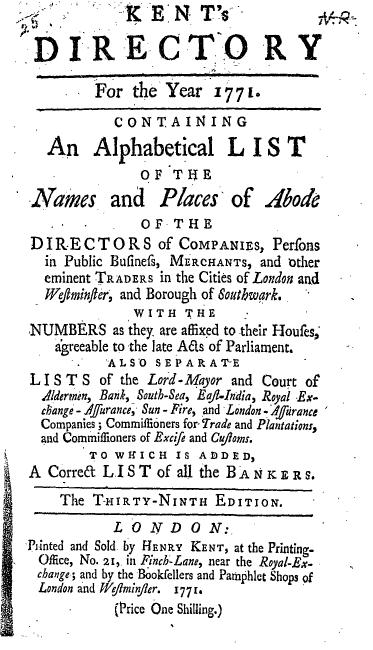The London and Westminster Directory, 1774 (DIR)
 Kent's Directory for the Year 1771. (1771). © Gale Cengage Learning and the British Library.
Kent's Directory for the Year 1771. (1771). © Gale Cengage Learning and the British Library.
Introduction
This dataset reflects the contents of Kent’s London Directory for the Year 1774. It includes 5,548 entries, reproducing the original entries in the directory, listing the names, addresses and occupations of a selection of major householders in London and Westminster. As with all eighteenth-century urban directories, it was neither comprehensive nor intended to be, and it includes a selection of the more prosperous inhabitants of London. This data has in turn been coded to include information about gender and a detailed breakdown of occupations.
The dataset forms a fragment of a larger project: The Directories Database, 1772-1787: Urban Occupations in Britain in the Early Industrial Revolution. Led by Professor Penelope Corfield, the project was funded by the ESRC (FOO/23/2007), and ran between 1983 and 1985. It created databases from fourteen urban directories covering the major urban areas of England, Scotland and Ireland. All fourteen databases, and an associated guide to the occupational coding incorporated in them, can be accessed from the UK Data Archive. While the database for London is available through this site for keyword and name searching, please refer to the UK Data Archive if you wish to undertake statistical analysis of this material. Copyright in this material remains with the original investigator, Professor Penelope Corfield, and the data are reproduced here by license, for non-commercial use only. The substantial outputs of the project included:
- Penelope J. Corfield. Power and the Professions in Britain 1700-1850. Routledge, 1995.
Back to Top | Introductory Reading
The Database
The dataset includes 5,548 records, each concerning a single individual or household. Where fields are blank in the original they have been suppressed in the version displayed here. Where information is available for each possible field the record will include the following:
- Unique Project ID: Unique identification number.
- Surname
- Forename
- Date of Publication: 1774 in all instances.
- Address: House number, or 0 where no number is given.
- Street Name: A standardised street name.
- Occupational Sector: A standardised occupational sector name.
- Occupational Grouping: A standardised sub-category of occupation.
- Occupation Code: A detailed standard occupational descriptor.
- Subsidiary Occupational Sector
- Subsidiary Occupational Grouping
- Subsidiary Occupational Code
- Male OR Female
- Status (eg. Esq.): Normally reserved for honorific titles.
- Business Premises: Yes/No.
Back to Top | Introductory Reading
 Ironmongers Hall in Fenchurch Street, c.1750. T. Loveday. London Metropolitan Archives, q6013417. © City of London.
Ironmongers Hall in Fenchurch Street, c.1750. T. Loveday. London Metropolitan Archives, q6013417. © City of London.
Occupations
The precise occupations and occupation sub-categories have been recorded in a coded form, based on a modified Booth/Armstrong schema. A comprehensive list of the codes employed can be accessed through the UK Data Archive.
These coded occupations have been aggregated into the following broad economic sectors:
- AG: Agriculture & Fishing
- MI: Mining
- BU: Building
- MF: Manufacturing
- TR: Transport
- DE: Dealing
- IS: Industrial service
- PP: Public Service/professional
- DS: Domestic Service
- XX: Unallocatable
This occupational coding schema is similar, but not precisely the same, as that employed by the Westminster Historical Database (WHD).
A typical entry, with blank fields suppressed, looks like:
- Unique Project ID: 2412
- Surname: Michie
- Forename: Jonathan
- Date of Publication: 1774
- Address: 0
- Street Name: CRAVEN ST STRAND
- Occupational Sector: DEALING
- Occupational Grouping: DE007
- Occupation Code: DE0070001
- Male OR Female: M
- Business Premises: N
Back to Top | Introductory Reading
Using this Dataset in London Lives
This database records householders from the middling sort and the elite, and as a result there is unlikely to be substantial overlap between the names included in it and the lists of criminals and paupers who form the primary focus of the London Lives site. There should, however, be substantial correlation between this directory and jurors listed in the Old Bailey Proceedings (OBP) (though it should be noted that householders from Westminster were excused from serving at the Old Bailey), and those sitting on Coroners' Inquests (IC). Given the status of those listed, many should also appear as parish officers, and in the records of St Thomas's Hospital, serving as governors listed in the Minutes of the Court of Governors (MG).
The names in this series are also likely to be found among several of the additional datasets included in London Lives. In particular, matches will be found in the rate books and voting records in the Westminster Historical Database (WHD); the abstracts of Wills Proved at the Prerogative Court of Canterbury (PCC); the Fire Insurance Policy Registers, 1777-1786 (FIR); and the salary records of 'Clerks' of the East India Company, 1760-1820 (EIC).
Original Sources
- Kent's London Directory for the Year 1774. (42nd edn, 1774).
Back to Top | Introductory Reading
Introductory Reading
- Barry, Jonathan, and Brooks, Christopher Wilson, eds. The Middling Sort of People: Culture, Society and Politics in England, 1550-1800. Basingstoke and London, 1994.
- Corfield, Penelope J. with Kelly, Serena. "Giving Directions to the Town": The Early Town Directories. Urban History Yearbook, 1984. 1984, pp. 22-35.
- Corfield, Penelope J. Power and the Professions in Britain 1700-1850. Routledge, 1995.
- Harvey, Charles, Green, Edmund, and Corfield, Penelope. Continuity, Change, and Specialization within Metropolitan London: The Economy of Westminster, 1750-1820. Economic History Review, 52 (1999), pp. 469-493.
- Prest, Wilfrid Robertson, ed. The Professions in Early Modern England. 1987.
- Schwarz, Leonard D. London in the Age of Industrialisation: Entrepreneurs, Labour Force and Living Conditions, 1700-1850. Cambridge, 1992.
Online Resources
- Corfield, P.J. and Kelly, S.M., Directories Database, 1772-1787
- British History Online, Dictionary of Traded Goods and Commodities, 1550-1820
- The Dictionary Project: Traded Goods and Commodities, 1550-1800
For further reading on this subject see the London Lives Bibliography.